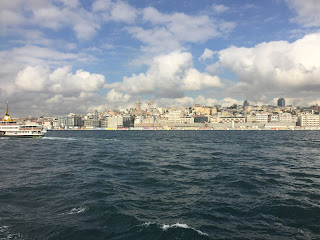As everyone knows I am a fan of Frank Still and all his
restaurants but the October ‘Food and Wine’ had a special article about Mr.
Stitt and his relationship with Richard Olney.
In the mid-1970’s Mr. Stitt was a philosophy major at the
University of California, Berkeley, concerned with aesthetics, the creation of
beauty, and the pursuit of authenticity. Where he found all that, though, was
in the kitchen work at Chez Panisse with Alice Waters. Alice Waters knew
Richard Olney and had used his cookbook The
French Menu Cookbook as a touchstone for her restaurant. Olney became a
friend and mentor to Waters. The philosophy at Chez Panisse was a radical
departure from what was happening in other American cities. And Stitt wanted to
go to the source of it, to meet Olney himself. So Waters helped make that
possible.
Stitt met the 51-year old Olney in the spring of 1978 in the
Time-Life studios on Conduit in London, where Olney was producing The Good Cook, a groundbreaking series
of 28 instructional cookbooks. Chef Jeremiah Tower was there too, and joined
Olney in France on a jaunt from Paris to Provence to cook and eat. Tower was
later a chef at Chez Panisse. Olney needed an assistance and Stitt was that
person.
Stitt reported for duty in Provence with a gift of fresh
morels. Stitt said, “I was going to the mountain to sit with Buddha.” That
month was one of the greatest highlights of his life. It was at dinner that the
main lessons took place. A pilgrimage to Olney’s meant four courses matched
with a progression of wines of growing intensity. And Scotch. Dinners would
last until 2 a.m. sitting under the arbor and drinking Laphroaig. At his table,
Olney conjured a vision of how one might live a beautiful life, with food and
drink at the center.
Stitt traveled across Europe chasing the magic of being at
table. He harvested grapes and made wine but the eventually came home to
Alabama. Stitt’s journey parallels that of American cuisine, an awakening that
started in earnest four decades ago as the country slowly emerged from a
post-war fog of convenience food and buffets of prime rib and bananas foster.
There is a framed photo of Richard Olney on the wall of Chez
Fonfon, Stitt’s bistro. Blink and you will miss it, but Olney’s values and the
magic and beauty of being at table endures.
Mr. Stiff created a seasonal menu to celebrate Richard Olney
and some of the ingredients and wines he loved. The menu is so fresh using what
is in season like figs with ham and walnuts, apple tart with an apricot glaze,
zucchini and herb-stuffed chicken. I chose to cook the eggplant and tomato
gratin. It was so earthy and delicious I have made it twice, so far.
From ‘Food and Wine, October’ 2017 but the first version originally
appeared in The Good Cook.
Provencal Eggplant-Tomato Gratin
Serves 4-6
6 small or medium eggplants (1 ½ lb.)
4 garlic cloves (1 crushed and 3 thinly slices divided)
1/3 cup plus 1 Tbsp. extra-virgin olive oil, divided
2 medium-size yellow onions, sliced (about 4 cups), divided
1 tsp. dried thyme
1 tsp. dried marjoram
¼ tsp. ground coriander
1 ½ tsp. kosher salt, divided
5 medium tomatoes, cored and cut into 6 slices each
1 tsp. freshly ground black pepper
6 button mushrooms, sliced
1/3 cup Niçoise olives, pitted and crushed
5 fresh bay leaves
1/3 cup fresh basil leaves, torn
Preheat the oven to 450 °F.
Trim stems from eggplants. If using medium eggplant, cut in
half lengthwise. Cut small eggplants or medium eggplant halves into 7 slices
each, cutting to, but not through, stem end. Eggplant should be able to be
fanned out without falling apart.
Rub a 13x9-iinch dish with crushed garlic clove, Drizzle 1
tablespoon olive oil in bottom of dish and rub to coat evenly. Place 2 cups
onion slices, thyme, marjoram, coriander, and one-third sliced garlic in an
even layer in the prepared dish. Arrange eggplant on top, and sprinkle with ¾
teaspoon salt. Place one tomato slice between each eggplant “fan blade.”
Sprinkle with pepper and remaining ¾ teaspoon salt. Top with remaining sliced
garlic, remaining 2 cups onions slices, mushrooms, olives, and bay leaves.
Drizzle with remaining 1/3-cup olive oil.
Cover dish tightly with aluminum foil. Bake in preheated
oven 15 minutes. Reduce oven temperature to 375°F (do not remove dish), and
cook until eggplant is almost tender, about 1 hour and 10 minutes. Remove and
discard foil, and bake until juices are slightly reduced and eggplant is very
tender, about 20 minutes. Garnish with torn basil.
Note: Baked gratin also holds well covered and refrigerated
overnight. Serve warm or at room temperature.

















































